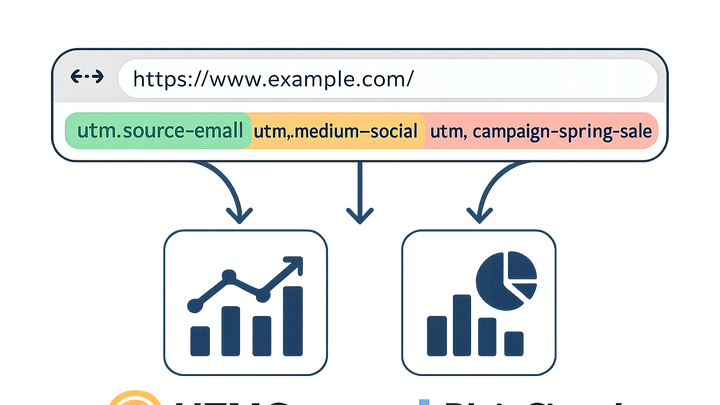Published on 2025-06-29T18:32:08Z
What Are URL Parameters? Examples for Campaign Tracking & Analytics
URL parameters, also known as query strings, are key-value pairs appended to a webpage URL that begin
with ? and are separated by &. In campaign tracking & analytics, these
parameters let marketers tag links with identifiers—such as source, medium, and campaign name—to attribute
web traffic and user actions to specific marketing efforts. By constructing and managing parameters
effectively, teams can track performance across channels and optimize future campaigns. Tools like UTMGuru
streamline tag creation and organization, while privacy-focused analytics platforms like PlainSignal can
capture and report on these parameters without relying on cookies.
Url parameters
Key-value pairs appended to URLs for tagging and tracking marketing campaigns, enabling precise attribution in analytics dashboards.
Definition and Purpose
URL parameters, or query parameters, are appended to URLs after a ? and follow the format
key=value. They enable passing contextual information—like campaign identifiers—within links.
This mechanism is fundamental for attributing traffic sources, segmenting users, and measuring the impact of
marketing efforts without altering base URLs.
-
Structure of url parameters
Parameters begin with
?and include one or morekey=valuepairs separated by&. For example:https://example.com/page?utm_source=google&utm_medium=cpc.- Key-value pairs:
Each parameter consists of a name and a value, such as
utm_source=google. - Delimiter characters:
?marks the start of the query string and&separates multiple parameters.
- Key-value pairs:
-
Role in campaign tracking
By tagging URLs with parameters, marketers can attribute sessions, conversions, and other user actions to specific campaigns, channels, or content variations.
Key UTM Parameters
UTM parameters are the industry-standard tags for campaign tracking. Each one serves a specific analytics purpose.
-
Utm_source
Identifies the traffic source (e.g.,
google,newsletter). -
Utm_medium
Specifies the marketing medium (e.g.,
cpc,email,social). -
Utm_campaign
Names the campaign to track performance across multiple channels (e.g.,
spring_sale). -
Utm_term
Tracks paid keywords or specific terms (useful for paid search campaigns).
-
Utm_content
Differentiates similar content or links within the same ad (e.g.,
cta_buttonvsheader_link).
Generating Parameters with UTMGuru
UTMGuru simplifies the creation, management, and organization of UTM-tagged URLs through a web interface and a Chrome extension. It enables teams to maintain consistent naming conventions and reuse past configurations.
-
Using the utm builder
Follow these steps to generate a tagged URL:
- Access utmguru:
Open the UTM builder at
utmguru.comor click the Chrome extension icon. - Fill in parameter fields:
Enter values for Source, Medium, Campaign, Term, and Content, adhering to your naming guidelines.
- Generate and copy url:
Click ‘Generate’ to produce the full URL with parameters, then copy it for your campaign.
- Save for later:
Use UTMGuru’s list feature to store and categorize your generated URLs for future reference.
- Access utmguru:
Tracking Parameters with PlainSignal
PlainSignal is a cookie-free analytics platform that captures URL parameters alongside event data to provide privacy-friendly insights into campaign performance.
-
Implementing the plainsignal script
Insert the following snippet into your site’s
<head>section to enable PlainSignal tracking:<link rel="preconnect" href="//eu.plainsignal.com/" crossorigin /> <script defer data-do="yourwebsitedomain.com" data-id="0GQV1xmtzQQ" data-api="//eu.plainsignal.com" src="//cdn.plainsignal.com/plainsignal-min.js"></script>- Preconnect link:
Establishes early connections to improve script loading performance.
- Script attributes:
data-dodefines your domain,data-idis your PlainSignal project ID, anddata-apipoints to the analytics endpoint. - Cookie-free tracking:
PlainSignal collects parameter and event data without storing cookies, ensuring better privacy compliance.
- Preconnect link:
-
Analyzing tagged urls
View referrer and UTM parameter data in PlainSignal’s dashboard to segment traffic sources, see campaign performance, and uncover user behavior trends.
Best Practices and Common Pitfalls
Ensuring data quality and consistency in URL parameter usage is key to reliable analytics. Avoid these frequent mistakes.
-
Maintain consistent naming
Use lowercase letters and a standardized format (e.g.,
spring_sale), so analytics platforms don’t treat variations as separate sources. -
Keep urls manageable
Limit parameters to the essentials to avoid lengthy URLs that may break or look unprofessional.
-
Properly encode values
Apply URL encoding for spaces (
%20) and special characters to ensure parameters are parsed correctly. -
Avoid pii in parameters
Never include personal or sensitive information in URL parameters to comply with privacy regulations like GDPR.
